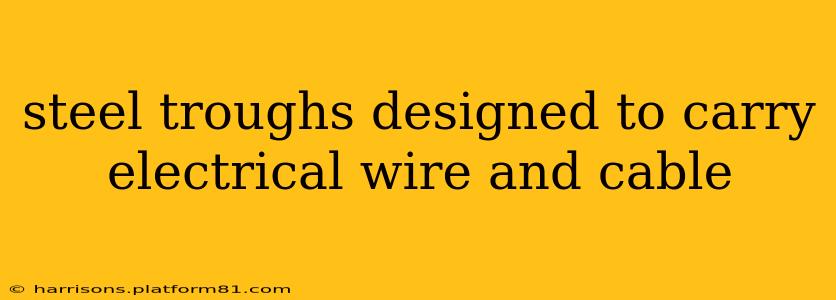Steel troughs provide a robust and reliable solution for organizing and protecting electrical wires and cables in a variety of settings, from industrial facilities to commercial buildings. Their strength, durability, and ease of installation make them a popular choice for managing large cable bundles and ensuring safe, efficient electrical distribution. This comprehensive guide explores the benefits, applications, and considerations when choosing steel cable troughs for your project.
What are Steel Wire Troughs Used For?
Steel wire troughs, also known as cable trays, are primarily used to support and protect electrical wiring and cabling. They offer a structured and organized system for routing cables, preventing damage from physical impacts, environmental factors, and potential short circuits. The specific applications are diverse, including:
- Industrial Settings: Factories, power plants, and manufacturing facilities often utilize steel troughs to manage extensive cable networks in heavy-duty environments.
- Commercial Buildings: Office buildings, shopping malls, and data centers benefit from the organized cable management provided by steel troughs, enhancing safety and maintainability.
- Infrastructure Projects: Steel troughs are integral to the construction of roads, bridges, and other infrastructure projects where cable protection is paramount.
- Outdoor Installations: Certain types of steel troughs, with appropriate coatings and protection, are suitable for outdoor applications where exposure to weather is a factor.
What are the Benefits of Using Steel Cable Troughs?
Steel troughs offer several key advantages over alternative cable management systems:
- Superior Strength and Durability: Steel's inherent strength provides excellent protection against physical damage, accidental impacts, and heavy loads.
- Fire Resistance: Steel troughs offer a degree of fire resistance, helping to contain and prevent the spread of flames in the event of a fire. However, fire ratings vary based on the trough's construction and any added fire-retardant coatings.
- Easy Installation and Maintenance: Steel troughs are relatively straightforward to install, often using simple connectors and fasteners. Maintenance is also simplified through easy access to the cables within the trough.
- Cost-Effectiveness: While the initial cost might be higher than some alternatives, the long-term durability and reduced maintenance needs of steel troughs often make them a cost-effective solution.
- Flexibility and Adaptability: Steel troughs are available in various sizes and configurations, allowing for customization to meet specific project needs.
What Types of Steel Are Used in Cable Troughs?
The type of steel used in cable troughs varies depending on the intended application and required strength and durability. Common choices include:
- Mild Steel: A common and cost-effective option suitable for many indoor applications.
- Galvanized Steel: Offers enhanced corrosion resistance, making it suitable for outdoor or humid environments.
- Stainless Steel: Provides superior corrosion resistance and durability, often chosen for harsh environments or applications requiring high levels of hygiene.
How are Steel Wire Troughs Installed?
Installation typically involves securing the troughs to supports using various mounting hardware, depending on the specific trough design and building structure. Careful planning of the cable routing is essential to ensure efficient installation and future maintenance.
What are the Different Types of Steel Cable Trays?
Several types of steel cable trays cater to diverse needs:
- Ladder-Type Troughs: These feature parallel side rails with rungs, offering good ventilation and cable accessibility.
- Channel-Type Troughs: These are enclosed channels, providing more protection for cables from damage and the environment.
- Solid Bottom Troughs: These provide maximum protection but may offer less ventilation.
What is the Difference Between Steel Cable Trays and Conduits?
While both are used for cable management, they differ in their design and application. Steel conduits completely enclose cables, offering superior protection against environmental factors and physical damage. Steel troughs, however, provide support and organization but leave cables more exposed. The choice depends on the level of protection required.
Are Steel Cable Troughs Suitable for Outdoor Use?
Yes, certain types of steel troughs, especially those made from galvanized or stainless steel, are designed for outdoor use. However, proper selection and installation are critical to ensure longevity and protection against weather elements.
What Safety Precautions Should be Taken When Installing Steel Cable Troughs?
Always follow relevant safety regulations and best practices during installation. This includes using appropriate personal protective equipment (PPE), such as safety glasses, gloves, and safety shoes. Proper grounding and bonding techniques should also be employed to ensure electrical safety.
This guide provides a comprehensive overview of steel cable troughs and their applications. Choosing the right type of steel trough depends on factors like the environment, cable type, and required protection level. Always consult with qualified electrical engineers and contractors to ensure compliance with relevant codes and standards.
